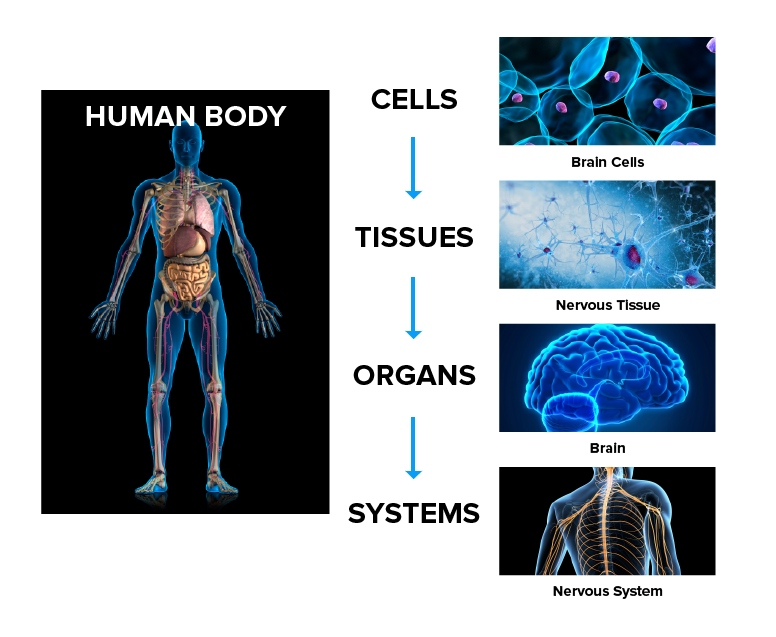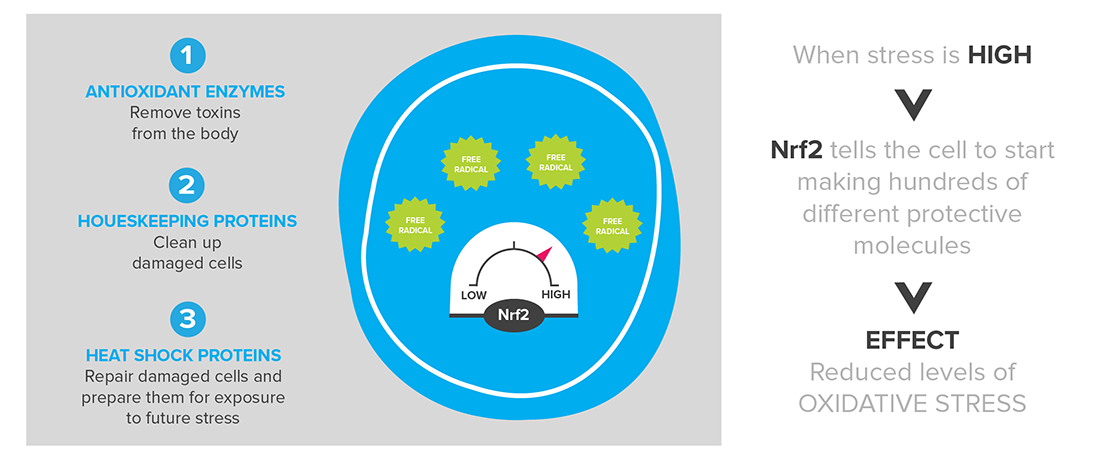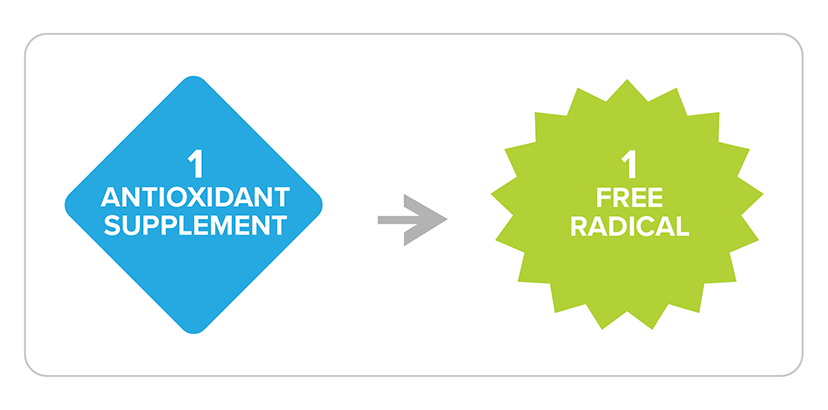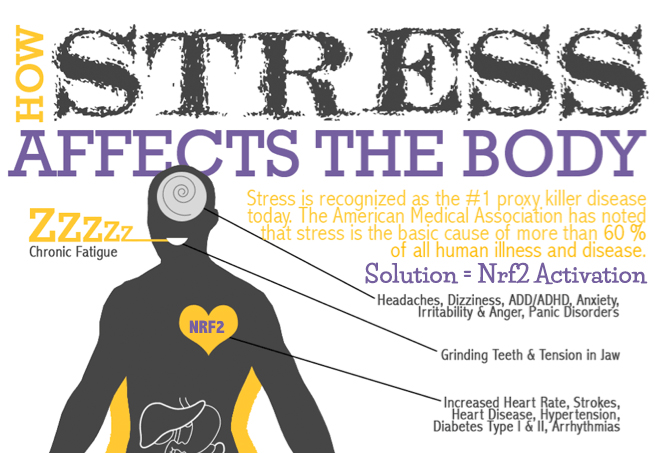Did you know that, over time, continued strain on your body from everyday stress can decrease your ability to LOOK, FEEL, & PERFORM your best?
Common Sources of Stress
The Culprit = OXIDATIVE STRESS
Environmental / Psychological / Nutritional / Physical / Financial
HOW STRESS EXPOSURE LEADS TO OXIDATIVE STRESS
The Human Body |
|
| The body is made up of about 37 trillion CELLS | · Bone cells
· Blood cells · Muscle cells · Nerve cells |
| Cells are collected into TISSUES | · Muscle tissue (muscles, heart)
· Nerve tissue (brain, spinal cord) · Epithelial tissue (stomach, intestine, lungs) · Connective tissue (tendons, skin, bone) |
| Tissues are arranged into ORGANS | · Heart
· Lungs · Brain · Stomach |
| Organs combine to form SYSTEMS | · Cardiovascular system
· Digestive system · Nervous system · Immune system |
THESE SYSTEMS MAKE UP THE HUMAN BODY
OPTIMAL BODY FUNCTION
- Cells work best when the body’s internal environment is kept constant.
- The body has many systems in place that work to keep the conditions inside of the body stable despite changes in the external environment.
- Cell function is disrupted when the body is unable to maintain a stable internal environment.

HOW STRESS AFFECTS YOUR BODY
Stress disrupts the body’s internal environment by altering hormone levels and introducing toxins. Under small amounts of stress, the body can correct the disruption by stabilizing hormone levels and reducing the toxins. High-stress loads overwhelm the system, challenging the body’s ability to course correct. This state of imbalance can be referred to as oxidative stress and represents the tipping point at which the disruptive forces coming from stress exceed the body’s defence mechanisms.
Initially, the imbalance can’t be felt and most often goes unnoticed. A disruption of the body’s internal environment wears on the cells and eventually, interrupts their ability to function normally. Cell malfunction leads to a disruption of entire body systems and at this point, the imbalance becomes apparent as it starts to affect your ability to look, feel and perform optimally.

Here is a brief introduction of how stress carries over to the different body systems:
The Digestive System
- Your digestive system (aka, your gut) has many responsibilities including: consuming and digesting food, absorbing the nutrients found in food, excreting waste and acting as a protective barrier against harmful substances. Interrupt any one of these functions and a variety of symptoms are likely to appear—think heartburn, abdominal pain, bloating, etc. Though many digestive issues are the result of poor lifestyle habits, research suggests that the stress you are exposed to on a regular basis can be detrimental to the health of your gut.
Read More – Stress & Your Gut (coming soon)
The Cardiovascular System
- This system is made up of your heart and blood vessels; its main function is to transport oxygen and nutrients around the body. Because of its large role in keeping other body systems working properly, maintaining a “healthy heart” is essential to overall well-being. Factors known to negatively impact heart health include: diet, activity levels and of course. . . stress.
Read More – Stress & Your Heart (coming soon)
The Nervous System
- The brain makes up a large portion of your nervous system. It functions as the so-called computer of the human body and is thought to be the most important organ. Without the brain, your ability to think, feel and control movement wouldn’t be possible; thus, protecting its health is a must. Stress, from a variety of sources, can have disruptive effects on the brain.
Read More – Stress & Your Brain (coming soon)
The Immune System
- The immune system is made up of many key players, all of which work to protect you from harmful invaders. Any breach of the immune system means a potential for disruption of body function; therefore, preventing exposure to things that can weaken your immune system is essential. Stress is one such offender and should be kept to a minimum to ensure optimal body function.
Read More – Stress & Your Immune System (coming soon)
The Endocrine System
- Your endocrine system is made up of glands (e.g., the thyroid gland and the adrenal glands) that secrete hormones into your blood. Its purpose is to act as an information signalling system, helping to carry messages throughout the body. The messengers are the hormones, all of which have very specific functions; for example, adrenaline initiates the fight-or-flight response, leptin decreases your appetite and growth hormone stimulates growth. Maintaining balance within the body is a key function of this system. Any force that interrupts the system can lead to imbalances in hormone levels which ultimately cause improper messages to be sent throughout the body. Stress is one such disruptive force.
The Muscular System
- Muscles make up a large portion of your body and are involved in many body functions. From helping you digest food to getting you from point A to point B, muscles are crucial for all the things you ask your body to do daily. To keep your muscles in good working, it’s important to incorporate weight baring exercises into your workout routine, switch up your workout routine regularly, eat a balanced diet (making sure to include protein at each meal), and you guessed it… minimize your exposure to stress.
The Skeletal System
- Bones make up your skeletal system; they give your body structure, provide protection for your organs and assist in movement. Your bones are in a continual state of remodelling, shifting from greater bone formation and growth during childhood to a balance between formation and breakdown during your young adult years. Eventually, the breaking down of bone outpaces bone formation which is the reason they become brittle as you age. There are many things you can do to maintain strong and healthy bones, with managing stress levels coming in near the top of the list.
IN A NUTSHELL

HOW TO PROTECT YOURSELF FROM OXIDATIVE STRESS
| Existing Solution | Antioxidant Supplements |
| What are antioxidants? | Nutrients found in dietary supplements. |
| What do antioxidants do? | Act like a sponge and protect cells against the damaging effects of toxins (i.e., free radicals) by absorbing the harmful molecules. |

THE FUTURE OF CELLULAR PROTECTION – NRF2
| What is Nrf2? | A structure (i.e., a protein) within cells of the body. |
| What does Nrf2 do? | Acts like a thermostat and regulates the level of stress within cells by managing the body’s own built-in cellular protection system.
When oxidative stress is high – Nrf2 tells the cell to start making hundreds of different protective molecules such as antioxidant enzymes, housekeeping proteins, and heat shock proteins. |

Nrf2 Provides Greater Cellular Protection vs. Antioxidant Supplements
Both Nrf2 and antioxidant supplements remove toxins that cause cell damage but with key differences…
Antioxidant Supplements
- Antioxidant supplements ARE NOT reusable
- Only removes toxins at a 1 to 1 ratio

WARNING – Consuming high-dose antioxidant supplements can actually lead to cellular damage by interfering with the body’s internal protective system. “More” is not “Better”
Nrf2
- Antioxidant enzymesproduced by Nrf2 ARE reusable
- 1 antioxidant ENZYME removes large amounts of toxins
- Cleans up damaged cells
- Enhances cell function
- Activates a response that protects cell against future stress

STEPS TO TRIGGER NRF2:
- Stop taking high-dose antioxidant supplements (e.g., vitamin A, vitamin C, and vitamin E).
- Get active.
- Practice intermittent fasting (once per month consume only water for 24 hours).
- Eat the right foods (e.g., blueberries, tea, coffee, apples, onions, broccoli, cabbage, and many more).
- Boost Nrf2 with properly balanced PHYTONUTRIENTS(i.e., nutrients found in plants that when combined, activate Nrf2 to a greater extent than when nutrients are consumed individually).
Protandim Nrf2 Synergizer
Protect yourself from stress.

